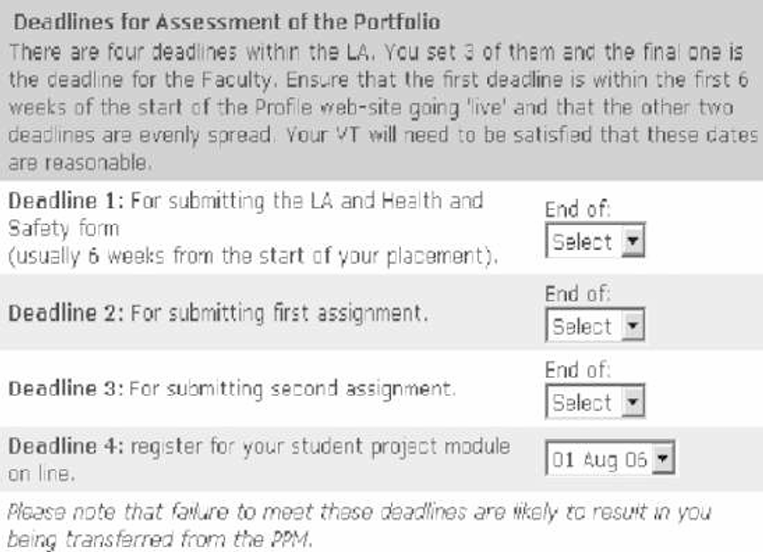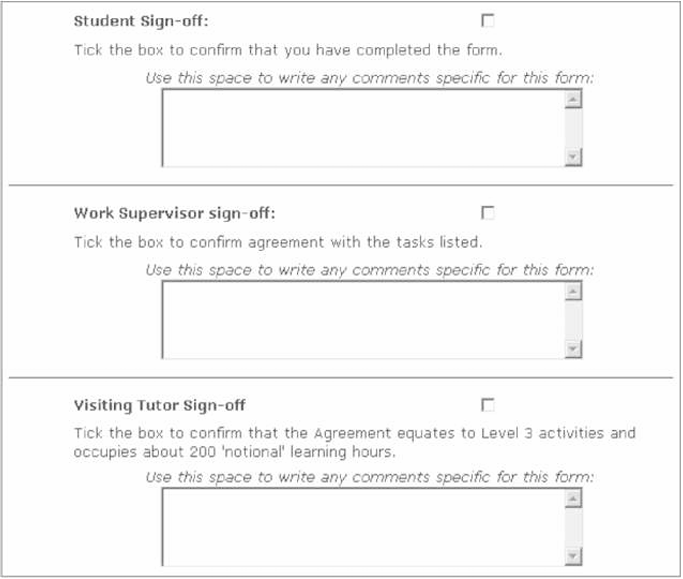
Learning Agreement web-form
 المؤلف:
Stephen Gomez & David Lush
المؤلف:
Stephen Gomez & David Lush
 المصدر:
Enhancing Teaching and Learning through Assessment
المصدر:
Enhancing Teaching and Learning through Assessment
 الجزء والصفحة:
P332-C28
الجزء والصفحة:
P332-C28
 2025-07-31
2025-07-31
 410
410
Learning Agreement web-form
The Learning Agreement (LA) web-form allows the student to show his/her learning during the placement period. The activities during placement are described in terms of tasks, with each task representing a learning opportunity. For science students, typical tasks may involve: learning a particular laboratory technique or procedure; data analysis or synthesis; formal presentations; report writing. The LA web-form consists of several sections which, in the diagrams below, are separated for ease of explanation. The following screenshots are of low resolution but the forms are available on request for you to view in more detail.
i. Identification fields
The LA web-form, like all other forms used to monitor placement learning, starts with student identification fields where the student enters his/her name and unique university student number (below).

ii. List of tasks
The next field on the web-form is a text-area into which the student enters the list of tasks they are hoping to perform on placement. The number and type of tasks are first negotiated with the work supervisor and agreed with the tutor. Each student lists between 5 and 10 tasks.

iii. Task deadlines
Four deadlines are set for the completion of the portfolio material. The final deadline is determined by us as all portfolios needed to be completed by 1 September for administrative purposes. The other deadlines are set by the student and agreed by the work supervisor and VT; these can vary according to the individual working practices of the placement but are spaced to ensure that the student works steadily on the portfolio rather than completing all the sections towards the end of the placement period.

iv. Sign off
The final section of the LA web-form contains three similar sub-sections, one each for the student, work supervisor and VT. The student ticks a checkbox as a 'sign off' that the form is complete and ready for assessment. A text area is also provided for any comments the student wishes to make. A similar section is provided for the work supervisor to sign off to confirm agreement with the LA; again, a box is provided for any comments. A third sign off area is for the VT to confirm agreement with the LA and that the task meets academic requirements. When all three sign-off checkboxes are selected, the form is locked so that the student cannot go back and make changes.

v. Submit button
At the bottom of the web-form is a Submit button which saves any valid changes made to the form when clicked.
 الاكثر قراءة في Teaching Strategies
الاكثر قراءة في Teaching Strategies
 اخر الاخبار
اخر الاخبار
اخبار العتبة العباسية المقدسة


